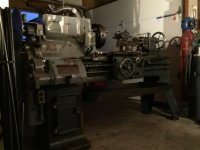I am trying to reduce the vibration in an old McDougall lathe. Long ago it was converted from belt drive to direct drive. The motor is mounted vertically in the base under the headstock and connected to the input shaft with something similar to
McMaster-Carr
There is some misalignment, which can be reduced, but wondering if there is a different style coupler on the market that will tolerate some misalignment and hopefully reduce vibration. After the original modification was done, the motor was replaced with a larger one. The size of the motor and the way it is mounted make it very difficult to line up the motor perfectly. Any suggestions would be appreciated.

McMaster-Carr
There is some misalignment, which can be reduced, but wondering if there is a different style coupler on the market that will tolerate some misalignment and hopefully reduce vibration. After the original modification was done, the motor was replaced with a larger one. The size of the motor and the way it is mounted make it very difficult to line up the motor perfectly. Any suggestions would be appreciated.



 But normally an automotive ring and pinion is optimized for the pinion to drive the ring gear in the forward direction. If it's driving backwards from that, with the ring driving the pinion ? Or even normally but with the pinion going the wrong direction ? I'd expect it to be extra noisy and rough. The teeth are now pessimized for that direction.
But normally an automotive ring and pinion is optimized for the pinion to drive the ring gear in the forward direction. If it's driving backwards from that, with the ring driving the pinion ? Or even normally but with the pinion going the wrong direction ? I'd expect it to be extra noisy and rough. The teeth are now pessimized for that direction.
